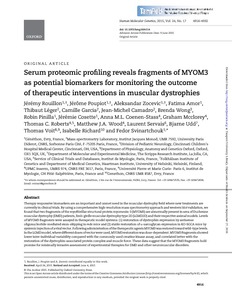Serum proteomic profiling reveals fragments of MYOM3 as potential biomarkers for monitoring the outcome of therapeutic interventions in muscular dystrophies
Rouillon, Jérémy; Poupiot, Jérôme; Zocevic, Aleksandar; Amor, Fatima; Léger, Thibaut; Garcia, Camille; Camadro, Jean-Michel; Wong, Brenda; Pinilla, Robin; Cosette, Jérémie; Coenen-Stass, Anna ML; Mcclorey, Graham; Roberts, Thomas C; Wood, Matthew JA; Servais, Laurent; Udd, Bjarne; Voit, Thomas; Richard, Isabelle; Svinartchouk, Fedor (2015)
Rouillon, Jérémy
Poupiot, Jérôme
Zocevic, Aleksandar
Amor, Fatima
Léger, Thibaut
Garcia, Camille
Camadro, Jean-Michel
Wong, Brenda
Pinilla, Robin
Cosette, Jérémie
Coenen-Stass, Anna ML
Mcclorey, Graham
Roberts, Thomas C
Wood, Matthew JA
Servais, Laurent
Udd, Bjarne
Voit, Thomas
Richard, Isabelle
Svinartchouk, Fedor
2015
Human Molecular Genetics 24 17
4916-4932
Lääketieteen yksikkö - School of Medicine
Julkaisun pysyvä osoite on
https://urn.fi/URN:NBN:fi:uta-201609272356
https://urn.fi/URN:NBN:fi:uta-201609272356
Tiivistelmä
Therapy-responsive biomarkers are an important and unmet need in the muscular dystrophy field where new treatments are currently in clinical trials. By using a comprehensive high-resolution mass spectrometry approach and western blot validation, we found that two fragments of the myofibrillar structural protein myomesin-3 (MYOM3) are abnormally present in sera of Duchenne muscular dystrophy (DMD) patients, limb-girdle muscular dystrophy type 2D (LGMD2D) and their respective animal models. Levels of MYOM3 fragments were assayed in therapeutic model systems: (1) restoration of dystrophin expression by antisense oligonucleotide-mediated exon-skipping in mdx mice and (2) stable restoration of α-sarcoglycan expression in KO-SGCA mice by systemic injection of a viral vector. Following administration of the therapeutic agents MYOM3 was restored toward wild-type levels. In the LGMD model, where different doses of vector were used, MYOM3 restoration was dose-dependent. MYOM3 fragments showed lower inter-individual variability compared with the commonly used creatine kinase assay, and correlated better with the restoration of the dystrophin-associated protein complex and muscle force. These data suggest that the MYOM3 fragments hold promise for minimally invasive assessment of experimental therapies for DMD and other neuromuscular disorders.
Kokoelmat
- Artikkelit [6140]
